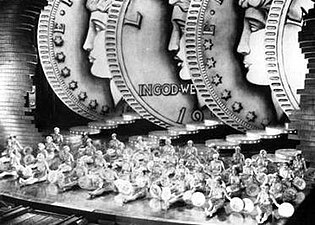
Footlight Parade is a 1933 American musical film directed by Lloyd Bacon, with songs written by Harry Warren (music), Al Dubin (lyrics), Sammy Fain (music) and Irving Kahal (lyrics). The film's numbers were staged and choreographed by Busby Berkeley. It starred James Cagney, Joan Blondell, Ruby Keeler and Dick Powell, with featured appearances by Frank McHugh, Guy Kibbee, Hugh Herbert, and Ruth Donnelly.

This is a list of notable events in music that took place in the year 1933.

Ethel Ruby Keeler was an American actress, dancer, and singer who was paired on-screen with Dick Powell in a string of successful early musicals at Warner Bros., particularly 42nd Street (1933). From 1928 to 1940, she was married to actor and singer Al Jolson. She retired from show business in the 1940s, but made a widely publicized comeback on Broadway in 1971.

Richard Ewing Powell was an American actor, singer, musician, producer, director, and studio head. Though he came to stardom as a musical comedy performer, he showed versatility and successfully transformed into a hardboiled leading man, starring in projects of a more dramatic nature. He was the first actor to portray private detective Philip Marlowe on screen.

Rose Joan Blondell was an American actress who performed in film and television for 50 years.

Harry Warren was an American composer and the first major American songwriter to write primarily for film. He was nominated for the Academy Award for Best Original Song eleven times and won three Oscars for composing "Lullaby of Broadway", "You'll Never Know" and "On the Atchison, Topeka and the Santa Fe". He wrote the music for the first blockbuster film musical, 42nd Street, choreographed by Busby Berkeley, with whom he would collaborate on many musical films.

Berkeley William Enos, known professionally as Busby Berkeley, was an American film director and musical choreographer. Berkeley devised elaborate musical production numbers that often involved complex geometric patterns. Berkeley's works used large numbers of showgirls and props as fantasy elements in kaleidoscopic on-screen performances.
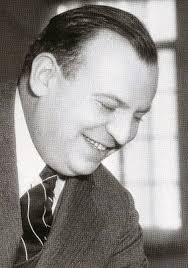
Alexander Dubin was an American lyricist. He is best known for his collaborations with the composer Harry Warren.

42nd Street is a 1933 American pre-Code musical film directed by Lloyd Bacon, with songs by Harry Warren (music) and Al Dubin (lyrics). The film's numbers were staged and choreographed by Busby Berkeley. It starred an ensemble cast of Warner Baxter, Bebe Daniels, George Brent, Ruby Keeler, Dick Powell, and Ginger Rogers.

Dames is a 1934 Warner Bros. musical comedy film directed by Ray Enright with dance numbers created by Busby Berkeley. The film stars Ruby Keeler, Dick Powell, Joan Blondell, Guy Kibbee, ZaSu Pitts, and Hugh Herbert. Production numbers and songs include "When You Were a Smile on Your Mother's Lips ", "The Girl at the Ironing Board", "I Only Have Eyes for You", "Dames" and "Try to See It My Way".
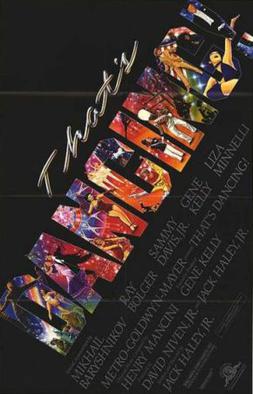
That's Dancing! is a 1985 American compilation film produced by Metro-Goldwyn-Mayer that looked back at the history of dancing in film. Unlike the That's Entertainment! series, this film not only focuses specifically on MGM films, but also included films from other studios.

George S. Barnes, A.S.C. was an American cinematographer active from the era of silent films to the early 1950s.

Roy Del Ruth was an American filmmaker.
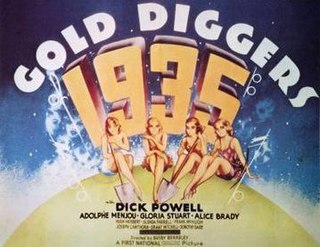
Gold Diggers of 1935 is an American musical film directed and choreographed by Busby Berkeley, his first time as a film's overall director. It stars Dick Powell, Adolphe Menjou, Gloria Stuart, Alice Brady, Hugh Herbert, Glenda Farrell, and Frank McHugh, and features Joseph Cawthorn, Grant Mitchell, Dorothy Dare, and Winifred Shaw. The songs were written by Harry Warren (music) and Al Dubin (lyrics). The film is best known for its famous "Lullaby of Broadway" production number. That song, sung by Shaw, also won the Academy Award for Best Original Song. The screenplay was by Manuel Seff and Peter Milne, based on a story by Robert Lord, who also produced the film, and Milne.

"The Gold Diggers' Song " is a song from the 1933 Warner Bros. film Gold Diggers of 1933, sung in the opening sequence by Ginger Rogers and chorus. The entire song is never performed in the 1933 movie, though it introduces the film in the opening scene. Later in the movie, the tune is heard off stage in rehearsal as the director continues a discussion on camera about other matters.
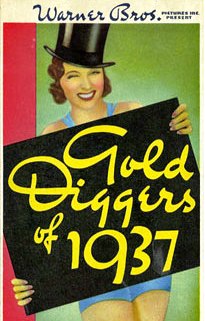
Gold Diggers of 1937 is a Warner Bros. movie musical directed by Lloyd Bacon with musical numbers created and directed by Busby Berkeley. The film stars Dick Powell and Joan Blondell, who were married at the time, with Glenda Farrell and Victor Moore.

The Gold Diggers is a Warner Bros. silent comedy film directed by Harry Beaumont with screenplay by Grant Carpenter based on the play The Gold Diggers by Avery Hopwood which ran for 282 performances on Broadway in 1919 and 1920. Both the play and the film were produced by David Belasco. The film stars Hope Hampton, Wyndham Standing, and Louise Fazenda. It was also the (uncredited) film debut of Louise Beavers.
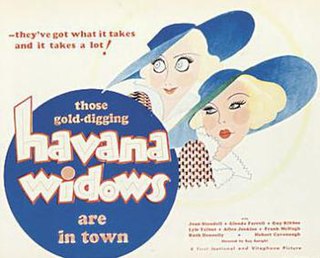
Havana Widows is a 1933 American pre-Code comedy film directed by Ray Enright, starring Joan Blondell and Glenda Farrell. It was released by Warner Bros. on November 18, 1933. Two chorus girls travel to Havana in search of rich husbands. Their target is Deacon Jones, a self-appointed moralist who cannot drink without getting drunk.

Colleen is a 1936 American romantic musical comedy film directed by Alfred E. Green and starring Dick Powell, Ruby Keeler, and Joan Blondell. It was produced and distributed by Warner Bros. and was the seventh and final picture starring both Keeler and Powell.

Stage Struck is 1936 American musical comedy film directed by Busby Berkeley and starring Dick Powell, Joan Blondell and Warren William. It was produced and distributed by Warner Brothers. The film's sets were designed by the art director Robert M. Haas.



